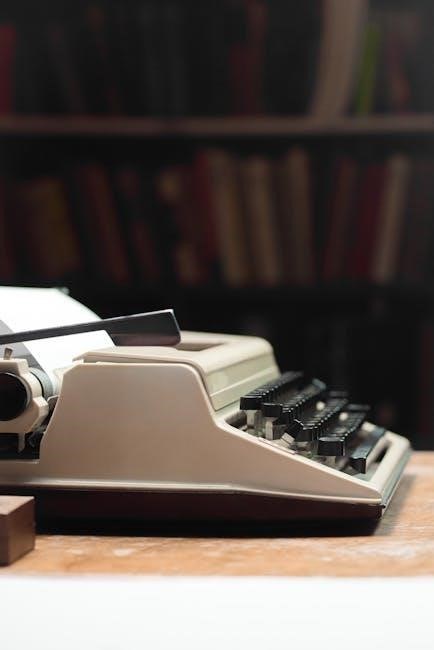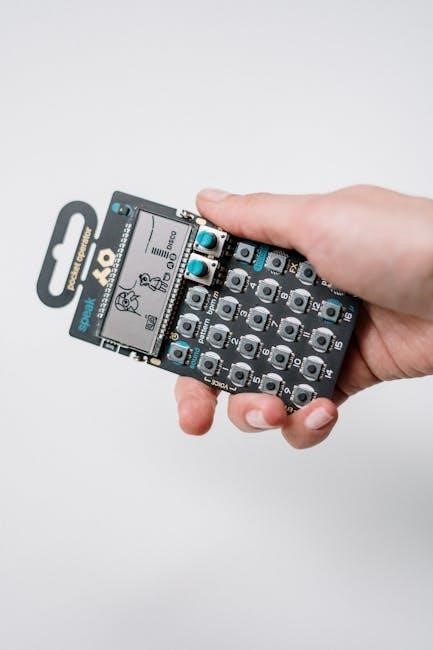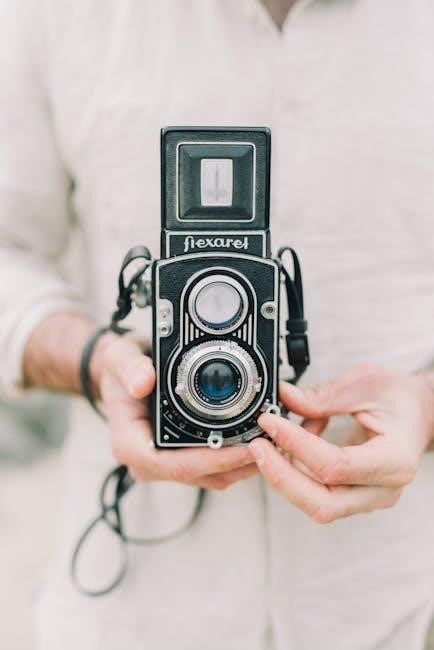
which feature of your manual propelling device
Manual propelling devices are essential human-powered solutions for marine navigation‚ ensuring easy reach and readiness while offering durability and user accessibility in various watercraft applications.
Definition and Purpose
A manual propelling device is equipment like oars‚ paddles‚ or anchors used to move a vessel using human power. Its primary purpose is to provide a reliable means of propulsion during engine failure or in calm waters. These devices ensure safe maneuvering and compliance with marine regulations‚ offering an essential backup system for emergencies. They are designed for easy reach and readiness‚ ensuring efficiency and safety during trips‚ while also meeting legal requirements for pleasure craft and small vessels.
Importance in Marine Safety
Manual propelling devices are vital for marine safety‚ serving as a reliable backup during engine failure or adverse weather. They ensure control and maneuverability‚ preventing drifting and potential collisions. These tools are legally required for small vessels and pleasure crafts‚ highlighting their critical role in emergency situations. By providing a means to propel or anchor a boat manually‚ they enhance safety and compliance with maritime regulations‚ protecting both passengers and the environment from unnecessary risks at sea.

Types of Manual Propelling Devices
Manual propelling devices include oars‚ paddles‚ and anchors‚ each designed for specific purposes like rowing‚ maneuvering‚ or stabilizing. Key features ensure durability and easy readiness for use.
Oars and Oarlocks
Oars are essential manual propelling tools‚ typically made of durable materials like wood‚ aluminum‚ or fiberglass. Oarlocks are U-shaped fittings that secure oars in place. They are often crafted from polyamide or chrome-plated brass for corrosion resistance. Jointed oars offer collapsible convenience‚ while traditional designs prioritize strength. Pre-trip inspections ensure oars and oarlocks are undamaged and securely attached. Proper handling and maintenance extend their lifespan‚ guaranteeing reliable performance during emergencies or regular use. Their design emphasizes ease of maneuverability and stability in various water conditions.
Paddles
Paddles are versatile manual propelling devices‚ available in single or double-bladed designs. They are constructed from durable materials like polyamide or fiberglass‚ ensuring resistance to harsh marine environments. Single paddles are ideal for small watercraft‚ while double-bladed versions‚ such as Canadian paddles‚ provide efficient maneuverability. Before each trip‚ inspecting paddles for cracks or damage is crucial to ensure functionality. Their lightweight and ergonomic design enhance portability and ease of use‚ making them essential for emergency situations and efficient navigation in various watercraft applications.
Anchors
Anchors are essential manual propelling devices‚ ensuring stability and control in emergencies. They must feature durable materials and secure fluke designs for effective holding. The anchor must be paired with at least 15 meters of rope‚ cable‚ or chain‚ and its condition should be inspected before each trip to ensure reliability. Proper storage and protection are crucial to maintain functionality‚ making anchors indispensable for safe and efficient navigation in various watercraft applications.
Other Devices ( Rudders‚ Paddle Wheels )
Other Devices (Rudders‚ Paddle Wheels)
Rudders and paddle wheels are specialized manual propelling devices that enhance steering and propulsion. Rudders provide directional control‚ while paddle wheels offer additional thrust. Constructed from durable materials like aluminum or fiberglass‚ these devices ensure resistance to marine environments. Regular inspections are crucial to identify wear or damage‚ ensuring optimal performance. Proper handling and storage are essential to maintain their functionality‚ making them reliable options for various watercraft‚ including sailboats and paddle boats‚ in emergencies or low-speed maneuvers.

Key Features to Consider
Key features include durability‚ ergonomic design‚ and portability‚ ensuring effective‚ easy‚ and reliable use in various marine conditions and emergency situations.
Durability and Material Quality
Durability and material quality are crucial for manual propelling devices‚ as they must withstand harsh marine environments. Devices made from durable plastics‚ aluminum‚ or fiberglass are ideal‚ offering resistance to corrosion and wear. High-quality materials ensure reliability and longevity‚ preventing failure during critical situations. Proper construction and finish also enhance performance‚ making the devices more efficient and easier to handle. Ensuring your manual propelling device is built with sturdy‚ marine-grade materials is essential for safety and effectiveness in various water conditions.
Ergonomic Design
Ergonomic design is vital for manual propelling devices‚ ensuring comfort and efficiency during use. Well-designed handles‚ balanced weight distribution‚ and adjustable lengths enhance user comfort‚ reducing fatigue. Proper ergonomics allow for better grip and control‚ making maneuvering easier. Devices designed with user accessibility in mind cater to diverse needs‚ ensuring safe and effective operation. An ergonomic design minimizes strain‚ enabling operators to maintain efficiency over extended periods‚ while also improving overall safety and performance in various marine environments.
Portability and Storage
Portability and storage are crucial features of manual propelling devices‚ ensuring they are easy to transport and stow. Lightweight materials‚ collapsible designs‚ and compact shapes enable effortless carrying and storage in limited spaces. Devices like paddles and oars often feature detachable or foldable constructions‚ making them ideal for small watercraft. Proper storage solutions‚ such as brackets or bags‚ protect the devices from damage and keep them secure. This practicality enhances their usability across various vessels‚ ensuring they remain accessible when needed without compromising performance or durability.

Legal and Regulatory Requirements
Manual propelling devices must meet legal standards‚ requiring oars‚ paddles‚ or anchors on pleasure craft‚ with anchors needing a minimum of 15 meters of rope.
Small Vessel Regulations
Small vessel regulations mandate that pleasure craft carry a manual propelling device‚ such as oars with oarlocks or a paddle. Devices must be easily accessible and ready for immediate use‚ ensuring safety during emergencies. Anchors are also classified as manual propelling devices and must include a minimum of 15 meters of rope‚ cable‚ or chain. Compliance with these regulations is crucial for legal operation and to ensure vessel maneuverability in case of engine failure or adverse conditions.
Mandatory Equipment for Pleasure Craft
Manual propelling devices are required for pleasure craft to ensure safety and compliance with regulations. These devices include oars with oarlocks‚ paddles‚ or anchors‚ which must be readily accessible. Oars and paddles should be sturdy and functional‚ while anchors must have a minimum of 15 meters of rope‚ cable‚ or chain. Carrying these devices ensures that operators can maneuver the vessel effectively in case of engine failure or other emergencies‚ adhering to legal and safety standards for pleasure craft operation.

Maintenance and Inspection
Regularly inspect manual propelling devices for cracks or damage‚ ensuring durability and functionality before each trip. Proper storage protects them from environmental stress‚ maintaining readiness for emergencies.
Pre-Trip Checks
Before each trip‚ inspect manual propelling devices for cracks or damage. Ensure they are within easy reach and ready for use. Check oars‚ paddles‚ and locks for proper function. Verify that all components are securely fastened and free from wear. This ensures reliability in case of engine failure or emergencies‚ providing peace of mind and safety while on the water.
Identifying Damage or Wear
Regularly inspect manual propelling devices for cracks‚ dents‚ or excessive wear. Check oars and paddles for splintering or breaks‚ and ensure oarlocks are securely attached. Look for signs of corrosion on metal components and fraying on ropes or chains. Test the flexibility of fiberglass or wood materials to ensure they remain sturdy. Addressing damage promptly prevents failure during use and ensures reliable performance in emergencies or routine operations. Consistent inspections maintain safety and extend the lifespan of the equipment.
Storage and Protection
Store manual propelling devices in a clean‚ dry place to prevent damage. Avoid exposure to direct sunlight or moisture‚ which can degrade materials. Secure oars or paddles upright or horizontally‚ ensuring they are tightly fastened to prevent shifting. Use protective covers or sleeves to shield against dust and abrasions; Regularly clean and inspect storage areas to avoid pest or mold issues. For seasonal storage‚ apply a rust-inhibiting coating to metal parts and ensure all components are dry to prevent corrosion. Proper storage extends the lifespan of your equipment.

Emergency Use and Safety
Manual propelling devices are crucial in emergencies‚ providing reliable propulsion during engine failure. Ensure they are easily accessible and ready for immediate use to enhance safety.
Manual Propelling in Engine Failure
Manual propelling devices are critical in engine failure scenarios‚ providing a reliable means to control and maneuver the vessel. Ensure the device is easily accessible and ready for immediate use. Regular inspections are essential to confirm functionality and prevent potential failure. Durable materials and ergonomic designs enhance efficiency during emergencies. Proper handling techniques can help maintain control and safety until assistance arrives or the engine is repaired.
Efficient Maneuvering Techniques
Efficient maneuvering with manual propelling devices requires proper technique and leverage. Using durable materials like aluminum or fiberglass ensures reliability‚ while ergonomic designs reduce fatigue. Maintain a steady rhythm and use body weight for added power. For oars‚ pivot from the hips and keep blades angled for maximum grip in water. With paddles‚ alternate sides smoothly and adjust stroke length based on speed needs. These methods enhance control‚ stability‚ and overall maneuverability‚ especially in challenging conditions.
Safety Features and Accessories
Safety features of manual propelling devices include durable materials‚ secure storage options‚ and visibility enhancements. Reflective coatings or LED lights improve visibility in low conditions. Anchors with adequate rope lengths ensure reliable stopping power. Flotation devices‚ like life buoys‚ are often paired with these tools for emergencies. Proper maintenance and regular inspections ensure reliability. Accessories like paddles with built-in whistles or oars with ergonomic grips enhance safety and functionality‚ making manual propulsion more secure and efficient in various marine situations.

Environmental and Practical Considerations
Manual propelling devices are crafted with durable materials like aluminum or fiberglass‚ ensuring resistance to harsh marine conditions while offering lightweight designs for easy portability and storage.
Resistance to Harsh Marine Environments
Manual propelling devices are built with durable materials such as aluminum‚ fiberglass‚ or polyamide‚ ensuring resistance to corrosion and wear in saltwater or rough conditions. Their robust construction withstands harsh marine environments‚ maintaining efficiency and reliability during emergencies. Proper maintenance‚ like regular cleaning and storage‚ further enhances their longevity‚ ensuring they remain functional in demanding situations. This durability makes them a reliable choice for various watercraft‚ including kayaks and sailboats‚ in both freshwater and saltwater settings. Their ability to endure challenging conditions is crucial for safety and performance‚ making them indispensable for marine safety and practical use.
Impact of Viscous Effects on Microscale Propulsion
Viscous effects dominate at microscale‚ making mechanical propulsion inefficient. Manual devices‚ like paddles or oars‚ rely on human effort to overcome viscosity‚ ensuring functionality in small-scale applications. Their simplicity avoids the inefficiencies of mechanical systems‚ making them practical for microscale propulsion. This highlights the importance of manual operation in overcoming viscous resistance‚ ensuring reliable movement in challenging environments where other methods fail. Their design focuses on maximizing efficiency despite these limitations‚ providing a viable solution for small watercraft and emergency situations.

User Tips and Best Practices
Ensure your manual propelling device is within easy reach and ready for use‚ checking for cracks or damage before each trip to maintain functionality and safety.
Ensuring Easy Reach and Readiness
Always ensure your manual propelling device is within easy reach and ready for immediate use. Store it in an accessible location to avoid delays during emergencies. Regularly inspect for damage or wear to maintain reliability. Proper storage and protection from harsh marine conditions are vital to preserve functionality. This ensures the device remains efficient and readily available when needed‚ enhancing safety and maneuverability in critical situations.
Proper Handling and Operation
Proper handling involves regular inspections for cracks or damage‚ ensuring readiness for use. Always maintain a firm grip on oars or paddles‚ using correct techniques to maximize efficiency. Store devices securely to prevent damage and ensure accessibility. Proper operation ensures safe and effective maneuvering‚ especially during emergencies. Regular maintenance and checks are crucial to uphold functionality and reliability‚ guaranteeing optimal performance when needed most. This ensures user safety and effective vessel control in all conditions.

Real-World Applications
Manual propelling devices are widely used in kayaks‚ sailboats‚ and canoes‚ offering reliable maneuverability in various water conditions. They ensure accessibility and fit for different users worldwide.
Use in Various Watercraft (Kayaks‚ Sailboats‚ etc.)
Manual propelling devices are versatile‚ used in kayaks‚ sailboats‚ canoes‚ and paddleboats. Oars and paddles provide efficient maneuverability in small vessels‚ ensuring control and stability. Sailboats often employ oars for docking or calm conditions‚ while kayaks rely on paddles for propulsion. These devices adapt to different watercraft needs‚ enhancing accessibility and functionality across various marine activities‚ making them indispensable for both recreational and emergency situations.
Accessibility and Fit for Different Users
Manual propelling devices are designed to accommodate diverse users‚ ensuring ease of use and ergonomic fit. Adjustable handles and lightweight materials enhance accessibility for individuals with varying strengths and mobility levels. Proper fit ensures efficient operation‚ reducing fatigue and improving control. These devices cater to different user needs‚ making them suitable for a wide range of watercraft enthusiasts‚ from seasoned sailors to recreational kayakers‚ promoting inclusivity and safety on the water.

Future Trends and Innovations
Advancements in materials and ergonomic designs are revolutionizing manual propelling devices‚ enhancing efficiency and user comfort. Innovations like adaptive materials and smart designs optimize performance in various marine environments.
Advancements in Materials and Design
Modern manual propelling devices feature innovative materials like lightweight‚ durable plastics‚ aluminum‚ and fiberglass‚ enhancing performance while reducing weight. Ergonomic designs improve comfort and efficiency‚ ensuring easy handling. Adjustable handles and balanced constructions cater to diverse user needs‚ while corrosion-resistant coatings protect against marine environments. These advancements ensure devices are both functional and long-lasting‚ meeting the demands of various watercraft users and emergencies. Such innovations prioritize accessibility‚ fit‚ and readiness for optimal user experience.
Integration with Other Marine Technologies
Manual propelling devices integrate seamlessly with advanced marine technologies‚ enhancing safety and efficiency. They complement GPS navigation systems‚ electronic charts‚ and communication devices‚ ensuring reliable operation in emergencies. Future innovations may include smart systems that combine manual and electronic propulsion for optimal performance. This integration underscores the importance of manual devices within modern marine technology ecosystems‚ ensuring readiness and accessibility for all users effectively.
Manual propelling devices are indispensable for marine safety and navigation‚ offering reliability in emergencies. Ensuring easy reach and readiness is crucial‚ alongside regular inspections for damage. Legal requirements mandate their presence on vessels‚ underscoring their importance. Future innovations will enhance materials and functionality‚ integrating with other marine technologies. By adhering to best practices and maintaining these devices‚ users can ensure safe and efficient operation‚ making manual propelling devices a vital component of modern watercraft navigation systems.

